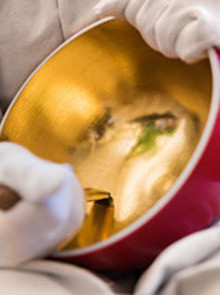In 2016, the Sèvres National Manufactory and Museum took up a new challenge well suited to its world-renowned expertise and search for perfection. It daringly decided to once again produce one of the most extravagant and emblematic works ever created at the Manufacture: the famous Vaisseau à mat potpourri vessel.
Over 250 years after the original edition acquired by Madame de Pompadour in 1760, Sèvres reproduces its “Masted Ship”, modelled after the original pink vase adorned with chinoiserie housed at the Louvre. Since 2017, a blue version of the vessel has also been produced.
Several years of technical research on the vase’s specific shape and colours were necessary to successfully perform this technical feat drawing upon a great variety of specialized skills employed in the 27 workshops at the Manufacture, in particular those dedicated to plaster moulding, small-scale casting and adornment.
While the original plaster model has been preserved all these many years at Sèvres, it alone does not suffice to produce a new edition. It was also necessary to rediscover forgotten skills and invent new techniques, while relying on the dexterity of the Manufacture’s talented artisans, in order to once again create this exceptional ceramic object.
In the 18th century, the Vaisseau à mât served as a perfume diffuser. Acquired by Madame de Pompadour from the Manufacture on 30 May 1760, the colours and motifs of this potpourri vessel were in harmony with the sumptuous interiors designed as veritable works of art for the marquise. A delightful object of everyday use, it was the central mantelpiece ornament at her Hôtel d'Evreux, today’s Elysée Palace.
In the Rococo style popular at the time, its shape created in 1757 by the “Goldsmith to the King” Jean-Claude Duplessis evokes the precious-metal vessels that adorned the royal tables. The openwork lid and body allow for the diffusion of perfume. The vase’s motif is based upon an engraving entitled Le Thé by the greatest French painter of the period, François Boucher. Painted by Charles-Nicolas Dodin, another famous Sèvres talent, the vessel is adorned with chinoiserie, this artist’s speciality.
Of the twelve vessels of varying motifs produced between 1757 and 1764 at the Manufacture de Sèvres, only ten Vaisseaux à mât are still in existence. Today, they are preserved at the world’s most prestigious museums: the Louvre in Paris, the Wallace Collection (London), Waddesdon Manor (United Kingdom), the Royal Collection (Buckingham Palace), the Metropolitan Museum of Art and the Frick Collection (New York), the Walters Art Gallery (Baltimore) and the J. Paul Getty Museum (Los Angeles).
This one-of-a-kind work born during the Age of Enlightenment is as striking as ever and embodies a real or fantasized French art de vivre: a fascinating page of history from Sèvres’ rich tangible and intangible heritage. A veritable feat of the ceramic arts, meeting multiple challenges of creation and transmission.





















